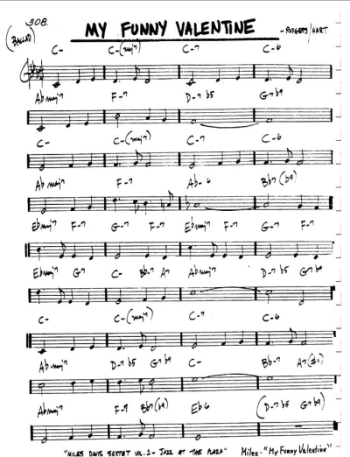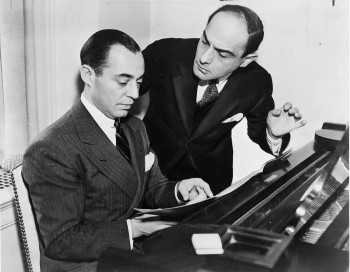.
.

.
.
Funny Valentine
They all crooned it,
the essential ballad-
Baker, Ella, Johnny Hartman
Miles on horn, Frankie Boy
Louis on horn and vocals-
They all crooned it.
Funny…
.
by George Held
.
George Held’s work has appeared in, among other periodicals, Blue Unicorn, Spring, Transference, and Two Cities Review and has received eleven Pushcart Prize nominations. Among his 22 books is the poetry chapbook Second Sight (2019); his forthcoming book, The Lucky Boy, collects nine of his short stories.
.
.
.
___
.
.
World Telegram staff photographer/via Wikimedia Commons

Richard Rodgers and Lorenz Hart, 1936
.
.
…..So many great songs to choose from for marking Valentine’s Day, the most obvious being Richard Rodgers and Lorenz Hart’s “My Funny Valentine,” which the poet George Held has succinctly honored.
…..Written for their 1937 Broadway musical Babes in Arms, the piece was overshadowed on Broadway (and in the film version starring Mickey Rooney and Judy Garland) by “Where or When,” “I Wish I Were in Love Again,” and “The Lady is a Tramp,” and was not made relevant until Frank Sinatra’s recording of it in 1953. It was eventually recorded by more than 600 artists on countless albums, and became synonymous with Chet Baker, who recorded it over 100 times. Will Friedwald, author of Stardust Melodies: The Biography of Twelve of America’s Most Popular Songs — an entertaining and essential work of popular music history — wrote that “the tune could be said to follow Baker from the grave, since it’s usually included in memorial tributes to him.”
….. Friedwald writes, “What makes the whole [song] so remarkable is the happy/sad nature of the lyric, brilliantly mirroring the major/minor nature of the music. It’s a love song, but far from those ‘I love you and everything’s rosy’ tunes so popular in the twenties (vis-a-vis Iriving Berlin’s ‘Blue Skies’). It’s vaguely optimistic, but it couldn’t be described as upbeat. Still, it’s far from a downer or a torch song like ‘Body and Soul.’ The sheet music instructs pianists to play the somewhat peppier verse ‘moderato,’ while the refrain should be rendered ‘slowly, with much expression.’ In truth, it is neither glad or unhappy.”.
.
…..“‘My Funny Valentine’ is a man’s idea of the way he imagines women think about men,” Friedwald continues. [The lead male character in the Broadway show was “Valentine ‘Val’ Le Mar,” and the song was sung to him by female lead Mitzi Green]. “Just as ‘Have You Met Miss Jones’ (from I’d Rather Be Right) is a man’s song and no amount of pronoun changing has ever made it suitable for a woman, ‘My Funny Valentine’ is essentially a woman’s song. That a number of men have sung it successfully — indeed, it’s probably most closely associated with Frank Sinatra and Chet Baker — is a testament to their abilities as interpreters. It’s affectionate and endearing for a woman to admit that she’s in love with a man even if his ‘figure’ is ‘less than Greek’ (i.e., not the Olympian ideal of masculine beauty) and his mouth is ‘a little weak.’ But a man, especially in old song lyrics, would never describe a woman in that fashion; when men list their criteria for feminine loveliness, ‘strong’ would not be the adjective they would use to describe the lips and mouth of their dream girl. Rule number one, dude, if you’re trying to get to first base with a chick, do not, under any circumstances, refer to her looks as ‘laughable.'”
…..Too many vocalists to mention here made the song “their own,” and instrumentalists like Miles Davis found the song suitable to their skill sets and career path. Friedwald writes that Davis “recorded the song several times, including a classic live version from 1958 (Jazz at the Plaza) with his great sextet of the period, featuring John Coltrane, Bill Evans (who also played it with Jim Hall), and Cannonball Adderley. It’s the same band that recorded the trumpeter’s classic album Kind of Blue, and it’s telling that ‘Valentine’ should be one of the major standards in the repertoire of this legendary ensemble. Davis returned to the tune in 1964 on another great live album, this one with his no-less-celebrated unit of the 1960s, spotlighting Wayne Shorter and Herbie Hancock. The Kind of Blue band and the sixties band had one major thing in common: these Davis units were among the first ensembles to explore the concept of modal jazz. It seems logical that ‘Funny Valentine’s’ unique harmonic sequence made it attractive to musicians who were thinking along those lines. Rodgers and Hart may have been contemplating the musical past with their allusions to classical, and possibly medieval and Renaissance, techniques, but somehow they wound up looking straight into jazz’s future.”.
…..From the time it was written until Sinatra’s recording of it in 1953, the tune was rarely recorded, but, as Friedwald points out, “within a few years it became one of the signature songs of the LP era.” There are way too many versions to list here, and whether your favorite version is Ella’s or Mulligan’s or Bird’s, or Chet’s or Sinatra’s, there are hundreds of others to discover along the way.
.
Some versions of Rogers and Hart’s “My Funny Valentine”…
.
Frank Sinatra, 1953 [Universal Music Group]
.
.
Ella Fitzgerald, 1956 [Universal Music Group]
.
.
Chet Baker, in a 1959 filmed performance
.
.
Miles Davis, in a 1964 filmed performance
.
.
___
.
.
Click here for information about how to submit your poetry
Click here to subscribe to the Jerry Jazz Musician quarterly newsletter
Click here to help support the continuing publication of Jerry Jazz Musician (thank you!)
.
.
.





























This past Sunday, a group of us here in Valencia discussed this song, getting into the lyric and melody while considering the reasons for its continued popularity. I just shared this link with them, and only wish that we had seen it earlier. A wonderful piece!